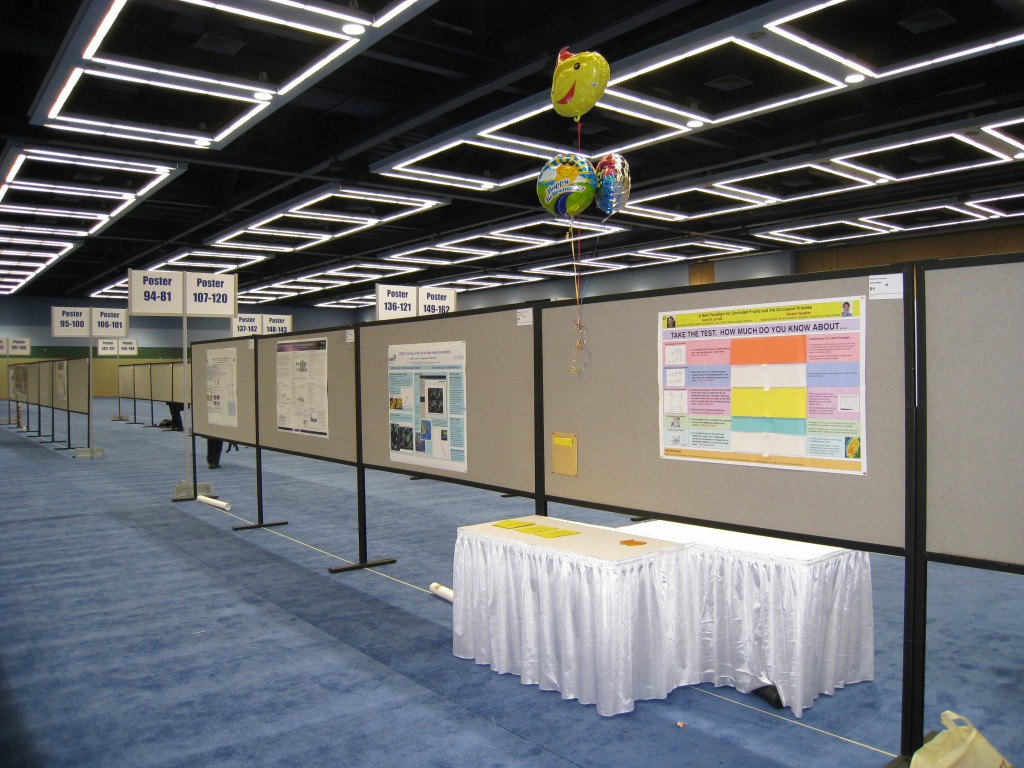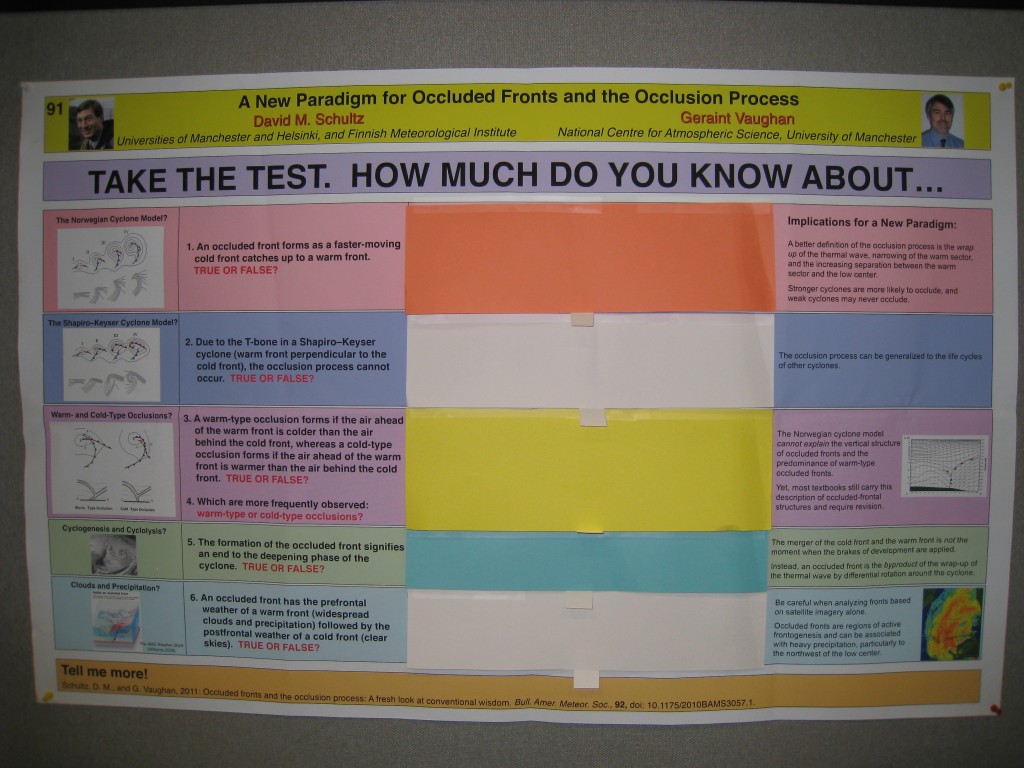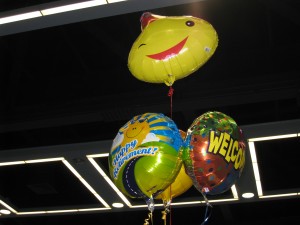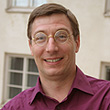Rethinking Poster Sessions as Second-Class
At first, I was furious. It’s the best research I’ve done in a while, and I wanted to present it publicly at the AMS Annual Meeting for all to see. Instead, the program committee gave me a poster.
Instead of throwing together a bunch of graphics and making a boring poster, I wanted to do something different to distinguish my work from the other posters. I wanted to build up some hype, and I wanted to engage people in discussion. I wanted to give people something to take with them to remind them of the poster and to give them a place to get more information about my research.
So, I designed the poster to engage people’s thinking. It was a test with six questions. The questions appeared on the poster and were also distributed as a bright yellow handout to visitors. You can see the handouts in an envelope on the posterboard and on the table.

You could get the answers from two places. One was on the back of the handout. The other was on the poster, where people had to flip up the flaps to see the answers to the questions.

Large balloons at the poster attracted people to the poster, even if just to see what the balloons were for.

By the time the poster session was over, it was one of the most engaging scientific activities I had ever done. Given that the average attendance at any given session was less than 100 people (and usually 30-50 people), I received more substantive feedback from people during the poster than the one or two polite questions I would have received had I given an oral presentation. I gave out nearly all my handouts, which meant that I directly interacted with at least as many as would have likely sat passively through an oral presentation. Plus, they got a handout to take home and remind them of my poster.
Getting rejected from an oral presentation in favor of a poster was one of the best things that happened to me! I want to thank the WAF/NWP conference organizers for that opportunity.
In the future, I will be more enthusiastic about presenting a poster than giving an oral presentation. In fact, I will probably ask for a poster instead.
To see the research upon which this poster is based, download the manuscript from the AMS Web site.
Schultz, D. M., and G. Vaughan, 2011: Occluded fronts and the occlusion process: A fresh look at conventional wisdom. Bull. Amer. Meteor. Soc., in press
UPDATE: See some of the people that stopped by the poster.



Dave, kudos for an innovative way to reach the primary goal of scientific exchange. NWS colleague Chris Buonanno uses a 7-inch digital picture frame attached to his laptop to display animiations. Digital picture frames can be mounted with the standard issue pins or a hanger-like hook over the top of the poster board. Obviously, a lightweight tablet-PC (e.g., iPad) could be used straightaway. Since poster sessions usually run 90-120 minutes, there is no need for AC power, just run on battery.
Despite these types of enhancements, I am increasingly troubled by the format of conferences, both oral and poster sessions. The now-standard 12-minute oral presentation plus three minutes Q/A is simply insufficient to give more than a fleeting glance toward a topic. Some of the best work is synthesis of the literature review, data processing, etc., but there is not enough time to cover those aspects in depth. I feel posters were more effective (as you discuss) 5-10 years ago when there were fewer in an individual session, and no concurrent sessions. Recent trends are toward packing 100 or more posters into 90-minute sessions, and/or having poster sessions concurrent with oral sessions. Even for a topically-focused conference, it’s hard to visit more than a handful of posters and have the type of discussion you experienced. Worse yet, similar papers (including mine) may be in the same poster session, thereby limiting interaction precisely with the colleagues most interested!
Of course, there are all kinds of considertations and pressures for the program committee, and certainly no easy, nor all-encompassing, remedy. One concept I’ve seen from another discipline is submission of presentation slides with the abstract, such that the program committee can select unique, revolutionary, and/or well-formed efforts that provide true learning are given longer length oral slots. Another idea is placing 10-12 similar topic posters in semi-circles rather than linerally. That layout and a good facilitator might inspire a study-group atmosphere with synergistic feedback within each semi-circle.
Good point, Jon. I was talking with my poster coauthor Geraint Vaughan about this. His point was that people preparing posters leave it until it’s too late and then just whip something together. I agreed that this was really indeed our problem. People view posters as a consolation prize, and so don’t put a lot of effort into them. If people changed their perspectives, we might have more engaging and energetic poster sessions.
Jon, your point about the conference format is probably worth another post. Suffice it to say that this poster session was only 1.5 hours and had too many posters to see during that time. Conference organizers do a disservice to most of the people that attend conferences in minimizing the length and importance of poster sessions.
One of the better poster sessions I recall was at the 2005 Mesoscale/Radar Conference in Albuquerque. Poster sessions started right after lunch at 1:15 and ran until and through the coffee break at 3:00, finishing at 3:30. Poster sessions ran Monday, Tuesday, and Thursday (Wednesday afternoon was free to explore the city or meet individually with colleagues). The great thing was that you didn’t have to rush back from lunch for an oral presentation at 1:30, and people were definitely back by 3:30 for the afternoon sessions. It broke up the long boredom of the day of talks from 9:00 a.m. to 5:00 p.m. and made people more likely to come and visit the poster sessions. With two big conferences like Mesoscale and Radar, it took a lot of restraint to limit the talks to only the best and to place a greater emphasis on posters. My compliments to the conference committee for the astute planning!
Here was the conference itinerary to see for yourself.
The smaller, focused conferences usually have great poster sessions with a great turnout. It is disappointing to hear that poster attendance would be so low (1 percent since attendance was reported to be in the 3000 range).
It is interesting that your approach was to be more interactive with your audience. I saw a poster by Jim LaDue at an SLS conference that sought direct audience participation. It also attracted lots of attention and fostered discussion.
It seems strange to be writing this because poster sessions are designed to do this yet the standard poster format (while great for organizing ideas in a limited space) seems to fail on a basic level since we need to resort to marketing tricks (e.g. balloons, video, computer animation). It makes me ponder how we can use the strengths of the poster format with new technology as suggested by Jon.
James, I think you hit the nail on the head. Posters really are marketing devices. So, to have an effective poster, you have to treat it like one. Think about the exhibition hall at a big conference. What do the different exhibitors do to get attention? Big computer screens. Giveaways (candy, pencils, USB drives). Scale models of satellites.
If you want an effective poster, make it attractive. Make it communicate your main point. Then, find some way to attract people to it. I will be even more prepared next time to take it one more notch up. 🙂
Look out, world.
Hello David,
I am a graphic designer, will be giving a presentation on the design of conference posters at the University of Zürich. I was wondering if I may use your a photo from your blog as a basis for an illustration of a poster session (w credentials if you wish): http://eloquentscience.com/wp-content/uploads/2011/02/IMG_2956.jpg
The photo will be heavily modified. The posters will be replaced by others, but I would like to keep the balloons 🙂 I very much enjoyed reading your post on the topic.
Many thanks
Osnat
Sure, happy to help. You have my permission.
Dave